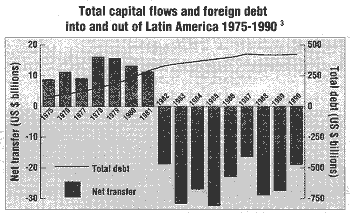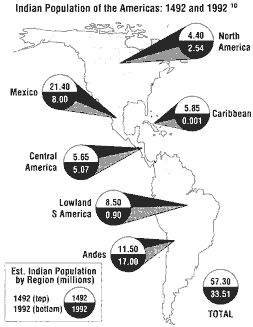|
|
|
new internationalist
issue 226 - December 1991
![]()
|
Christopher
Columbus inaugurated a colonial era that profoundly altered the future
of Europe, the Americas - and the rest of the world. This imperial ethic
continues today with the impoverishment of the developing nations, the
degradation of the natural environment and the stain of racism.
|
1 Golden
dreams
Imperial powers have been pumping wealth out of the Americas for nearly
five centuries.
 •
Columbus forced the Taino Indians in Hispaniola to bring him an ounce of gold
every three months. Those who didn’t had their hands chopped off while escapees
were hunted down with dogs. Despite these desperate measures, Columbus never
found his El Dorado.1
•
Columbus forced the Taino Indians in Hispaniola to bring him an ounce of gold
every three months. Those who didn’t had their hands chopped off while escapees
were hunted down with dogs. Despite these desperate measures, Columbus never
found his El Dorado.1
• Between 1500 and 1650, 180-200 tons of American gold were added to the European treasury, worth an estimated $2.8 billion in today’s terms.2
• The haemorrhage continues: from 1982-1990, $200 billion more left the Americas through interest payments and profits than came in from new loans and investment. Foreign debt grew from $288 billion to $423 billion during the same period.3
2 Plagues
and pestilence
The diseases which invading powers brought with them to the Americas continue
to devastate peoples who inhabit the remotest regions of this continent.
• Fifteen major epidemics raged through the Americas within a century of Columbus: 40 to 50 million native Americans died by the year 1600, equivalent to half a billion people today.1
• Old world pathogens swept the land, killing between a third and a half of the people in the Inca empire. From 1635-40 nearly half the Huron people in ‘New France’ died from diseases brought by Jesuit missionaries and traders.4
• Today isolated native groups still die from common diseases to which they have no immunities. When miners invaded their land in the late 1980s nearly 2,000 Yanomami Indians in northern Brazil died in the first two years. Survival International says the Yanomami may be disappear within a decade.5
3 Tyranny
and poverty
Colonialism in the Americas separated Indians from their
land, destroyed traditional economies and left native people among the poorest
of the poor.
 •
The Spanish ran the Bolivian silver mines with a slave labour system known
as the mita; nearly eight million Indians had died in the Potosi mines by
1650.6
•
The Spanish ran the Bolivian silver mines with a slave labour system known
as the mita; nearly eight million Indians had died in the Potosi mines by
1650.6
• Suicide and alcoholism are common responses to social dislocation. Suicide rates on Canadian Indian reserves are 10 to 20 times higher than the national average.7
• In Guatemala life expectancy for non-natives is 61 years; for Indians it is 45. The infant mortality rate for Indian children is twice that of non-Indians (160 deaths per thousand versus 80).8
• In the Amazon, oil companies are invading the territory of the Huarani people and the Ecuadorean Government refuses to recognize the Indians’ land rights.9 In northern Quebec the Cree are fighting a government plan to flood 350,000 square kilometres in violation of a 1975 land claims treaty.
4 Slavery
and racism
Slavery left a legacy of racism which haunts the Americas.
• Columbus was an enthusiastic slaver. On his first voyage he sent six Taino Indians back to Spain and on his second he shipped back 500 natives. ‘Let us in the name of the Holy Trinity go on sending all the slaves that can be sold,’ he wrote.1
• By 1800 nearly 15 million Africans had been brought to the new world. Another 50 million black people are estimated to have died en route or soon after arrival. When Europe finally gave up slavery at the end of the 18th century, one in four Africans were slaves.11
• Racism continues to plague the Americas. In general, whether in Brazil or the US, the blacker you are the poorer you are. In Washington, DC the mortality rate for black children is 26 deaths per thousand births - higher than many Third World nations including Cuba and Jamaica.12
5 The
wild and the sacred
Europeans had an exploitative and antagonistic attitude
towards the environment which contrasted with the respect native people held
for nature.
• The Tzotzil Maya in the Guatemalan highlands believe that digging a fingernail into maize to test its ripeness hurts the maize as it would a person.13
• Two centuries later the American Bison was hunted almost to extinction in the space of a decade. From 1872-74 alone more than 3 million buffalo were killed on the US plains. By 1885 the animal which had sustained the plains Indians for generations was gone. The killer-hero ‘Buffalo Bill’ Cody himself shot 4,280 of the animals in 18 months.14
• The relentless consumption of finite natural resources continues to scar the landscape of the Americas. Rapid deforestation in Central America for cattle grazing and cash crops like cotton has left depleted soils poisoned with chemicals. Central America is the world’s highest per capita consumer of pesticides while Costa Rica loses 2.5 tons of soil for every kg of beef exported.’15
6 Resistance
and Survival
Native Americans continue to resist the attack on their
culture and traditions. Today Indian peoples are stronger and more united
than at any time since the arrival of Columbus.
• In 1781 Tupac Amaru, a Mestizo descendant of the Inca emperors, led an Indian uprising against the Spanish in Bolivia. He abolished forced labour and slavery and attracted thousands of followers before he was eventually captured and killed by the colonizers.2
• In Bolivia in 1990, more than 800 Indians from the Amazonian lowlands marched for 33 days to La Paz to demand that lumber companies and cattle ranchers stop stealing their land. Indian leaders from the Andean highlands had an historic meeting with their lowland colleagues en route.16
• The Mohawk community of Kanesatake outside Montreal set up barricades in the summer of 1990 to protest against traditional burial lands being turned into a municipal golf course. The Canadian Government called out the Army and the two-month confrontation galvanized Indians and their supporters across North America.
• Indian organizations in Central America, South America, Mexico, the US and Canada have been organizing education campaigns and public protests against ‘official’ Columbus Quincentennial celebrations since 1988. Their aim is to expose the hidden history of colonialism and build a new relationship between natives and non-natives based on justice.
1 Columbus: His
Enterprise - Exploding the Myth. Hans Koning (Monthly Review Press/Latin
America Bureau, 1991).
2 Indian Givers, Jack Weatherford (Ballantine Books. New York,
1988).
3 Economic Commission on Latin America and the Caribbean. 1990.
4 ‘The Jesuits and the Fur Trade’. Bruce Trigger, from Sweet Promises,
ed. J R Miller, (U of T Press, Toronto, 1991).
5 Yanomami Survival Campaign. Survival International. London,
UK, 1990.
6 SEDOS Bulletin. Rome. May. 1990.
7 The Dispossessed, Geoffrey York (Lester & Orpen Dennys. Toronto.
1989).
8 Guatemala: False Hope. False Freedom. James Painter (CIIR,
London. 1987).
9 Ecuador urgent Action Bulletin. (Survival International. London,
1990).
10 Native Population of the Americas in 1492. ed. W Denevan
(university of wisconsin Press, 1976) and GAIA Atlas of First Peoples.
Julian Burger (Doubleday. New York. 1990).
11 A People’s History of the United States, Howard Zinn (Harper
& Row, New York. 1980).
12 Bright Futures or Broken Dreams, Children’s Defence Fund
(Washington. 1991).
13 Maya History and Religion. J. Thompson (university of Oklahoma
Press, 1970).
14 Beyond Geography, Frederick Turner (Rutgers University Press,
New Brunswick, NJ. 1986).
15 Faces of Latin America, Duncan Green (Latin America Bureau/Monthly
Review, 1991).
16 ‘The Hand That Feeds us’, Susanna Rance (from Report on the Americas,
July. 1991).